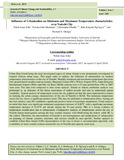| dc.contributor.author | Ndolo, Isaac John | |
| dc.contributor.author | Nzioka, John Muthama | |
| dc.contributor.author | Oludhe, Christopher | |
| dc.contributor.author | Ng’ang’a, John Kinyuru | |
| dc.contributor.author | Odingo, Richard S. | |
| dc.date.accessioned | 2018-07-17T13:33:35Z | |
| dc.date.available | 2018-07-17T13:33:35Z | |
| dc.date.issued | 2018-04 | |
| dc.identifier.issn | ISSN: 25230913 | |
| dc.identifier.uri | http://hdl.handle.net/11295/103472 | |
| dc.description | Journal Article | en_US |
| dc.description.abstract | Urban Heat Island being the most investigated aspect of urban climate is not prominently investigated in
tropical African urban areas. This paper seeks to address the influence of urbanization on outdoor
temperature characteristics in the city of Nairobi. Monthly minimum and maximum temperature data from
four ground-based weather stations namely, Dagoretti Corner (DC), Wilson Airport (WA), Jomo Kenyatta
International Airport (JKIA) and Moi Air Base (MAB) stations over a 47-year period from 1961 to 2007
were used. The data were subjected to time series analysis. Station to station correlation analysis was
performed as an indicator of the linear association of station records and also to understand spatial
variability. Spatial analysis of temperature across the city pointed out that the most representative station
in studying the urban canopy characteristics of the city of Nairobi is MAB. The minimum temperature
across the city shows a significant positive trend. This may be attributed to urbanization effect. Among all
the four stations, only DC exhibited a significant positive trend of maximum temperature. Trend analysis
revealed that there was significant minimum temperature increase of 0.430C with a significant maximum
temperature increase of 0.110C per decade during the 47-year period. This is a strong evidence of
temperature modification due to urbanization. Comparative analysis of temperatures across the city of
Nairobi depict heterogeneity among the four weather stations, with MAB being the hottest while DC is
the coldest. Therefore, the microclimate of Nairobi is not homogeneous and implications of urbanization
on planning of climate sensitive structures and services should be area specific. Further analysis to
establish Urban Heat Island (UHI) characteristics of the city in future is recommended especially with
availability of more weather stations around the city of Nairobi and adjacent rural areas. | en_US |
| dc.language.iso | en | en_US |
| dc.publisher | Journal of Climate Change and Sustainability | en_US |
| dc.rights | Attribution-NonCommercial-NoDerivs 3.0 United States | * |
| dc.rights.uri | http://creativecommons.org/licenses/by-nc-nd/3.0/us/ | * |
| dc.subject | Climate Change | en_US |
| dc.subject | Urbanization | en_US |
| dc.subject | Nairobi | en_US |
| dc.subject | Temperature | en_US |
| dc.subject | Rain | en_US |
| dc.title | Influence of Urbanisation on Minimum and Maximum Temperature characteristics over Nairobi City | en_US |
| dc.type | Article | en_US |



